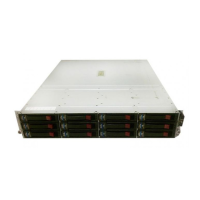• Hardware redundancy
NOTE:
For more information about high-availability configurations when using the HP B-series MP Routers
or C-series VSANs, see “High-availability MP Router configurations” on page 74.
Several factors affect SAN data availability:
• Application software
• Server operating systems
• Server hardware
• SAN fabric infrastructure
• Primary and secondary storage
• Number of switches
• Number of ISLs
• Number of paths between a server or clustered servers and the fabric
• Number of storage controller paths in the fabric
Levels
This section describes the data availability levels.
Level 1: single connectivity fabric
Level 1 provides maximum connectivity but does not provide fabric resiliency or redundancy. Each
switch has one path to other switches in the fabric (Figure 12). Each server and storage system has
one path to the fabric.
Figure 12 Level 1: single connectivity fabric
.
Level 2: single resilient fabric
Level 2 provides fabric path redundancy by using multiple ISLs between switches (Figure 13). Each
server and storage system has one path to the fabric. If an ISL or switch port failure occurs, the switch
automatically reroutes data through an alternate fabric path and there is no interruption in server I/O
activity.
SAN fabric topologies54

